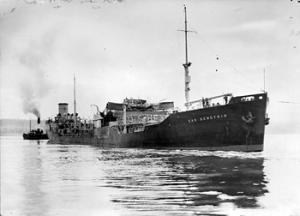MV San Demetrio

MV San Demetrio
|
|
| History | |
|---|---|
|
|
|
| Name: | San Demetrio |
| Namesake: | Saint Demetrius of Thessaloniki |
| Owner: | Eagle Oil & Shipping Co Ltd |
| Builder: | Blythswood Ship Building Co,Scotstoun |
| Yard number: | 52 |
| Launched: | 11 October 1938 |
| Out of service: | 1942 |
| Homeport: | London |
| Identification: |
|
| Fate: | Sunk by U-404 on 17 March 1942 |
| General characteristics | |
| Class and type: | Oil tanker |
| Displacement: | 8,073 GRT |
| Length: | 463.2 ft (141.2 m)/479 ft 5 in (146.13 m) |
| Beam: | 61.2 ft (18.7 m) |
| Draught: | 27 ft 1⁄2 in (8.24 m) |
| Depth: | 33.1 ft (10.1 m) |
| Installed power: | 502 NHP |
| Propulsion: | 8-cylinder 4-stroke single-acting marine diesel built by John G. Kincaid & Co Ltd, Greenock |
| Speed: | 12 knots (22 km/h) |
| Complement: | 45 officers & men; 8 DEMS gunners |
| Armament: |
|
MV San Demetrio was a British motor tanker, notable for her service during the Second World War. She was built in 1938 for the Eagle Oil and Shipping Company. In 1940 she was damaged by enemy action in mid-Atlantic, abandoned by her crew but later re-boarded and successfully brought into harbour. She was the subject of a 1943 feature film, San Demetrio London, one of the few films that recognised the heroism of the UK Merchant Navy crews during the War.
San Demetrio was one of several motor tankers of about 8,000 GRT built for Eagle Oil and Shipping in the latter 1930s. She was built by the Blythswood Shipbuilding Company of Glasgow, who had also launched her sister ships San Conrado in 1936 and San Cipriano in 1937.
San Demetrio had loaded 11,200 tons of aviation fuel in Galveston, Texas and was bound for Avonmouth, England. She was one of 38 ships that joined Convoy HX-84 for the passage across the north Atlantic and left Halifax, Nova Scotia on 28 October 1940. The Wickes-class destroyer HMCS Columbia (I49) and Clemson-class destroyer HMCS St. Francis (I93) escorted the convoy out of Canadian home waters but once clear of the coast, the convoy's sole escort was the armed merchant cruiser HMS Jervis Bay — a converted passenger liner that had been armed with seven outdated BL 6 inch Mk VII naval guns and a pair of 3-inch (76 mm) anti-aircraft guns.
...
Wikipedia
